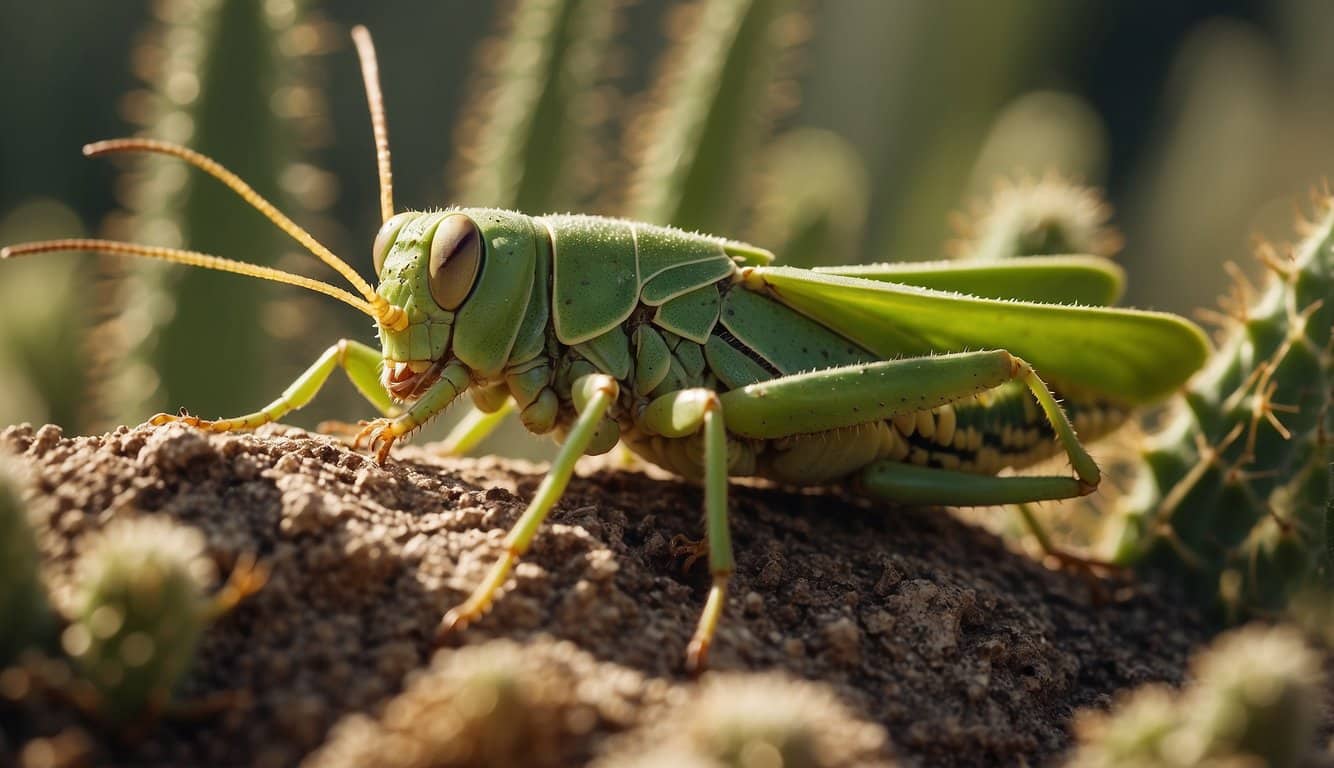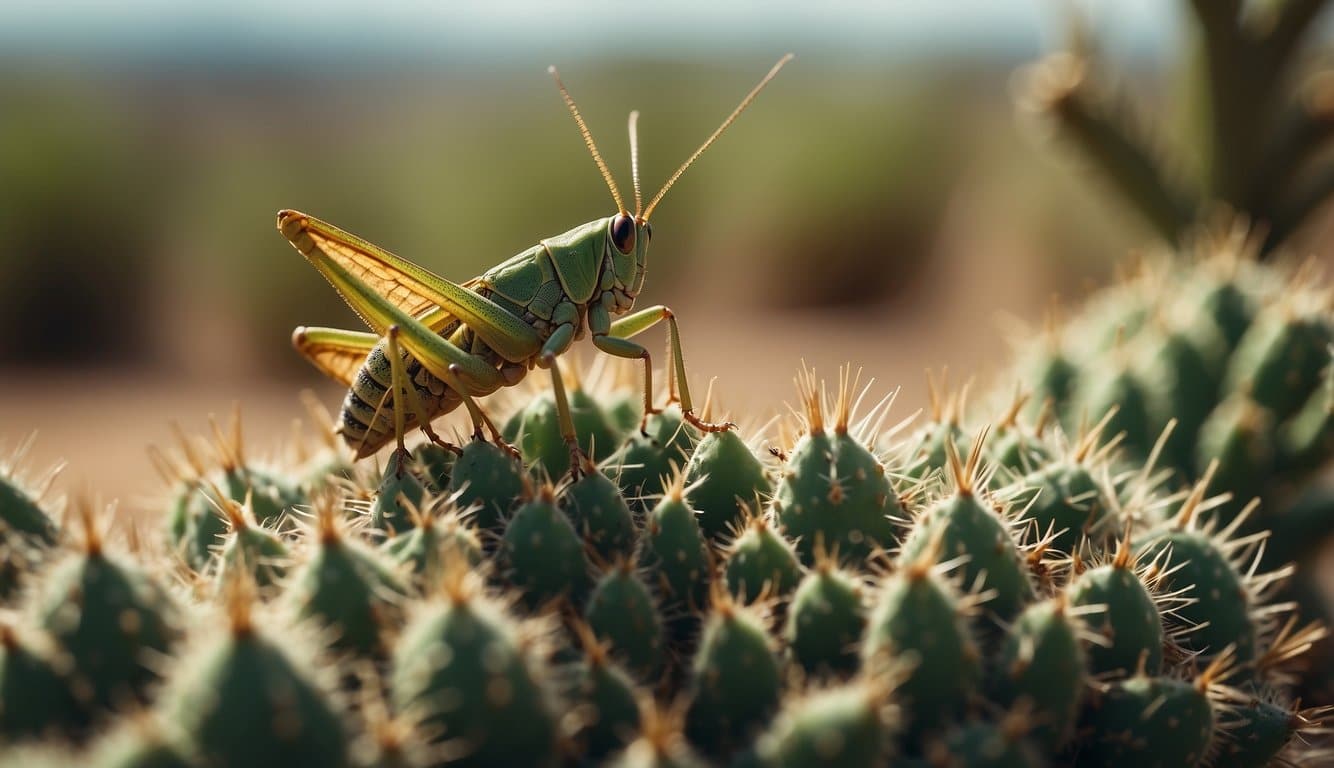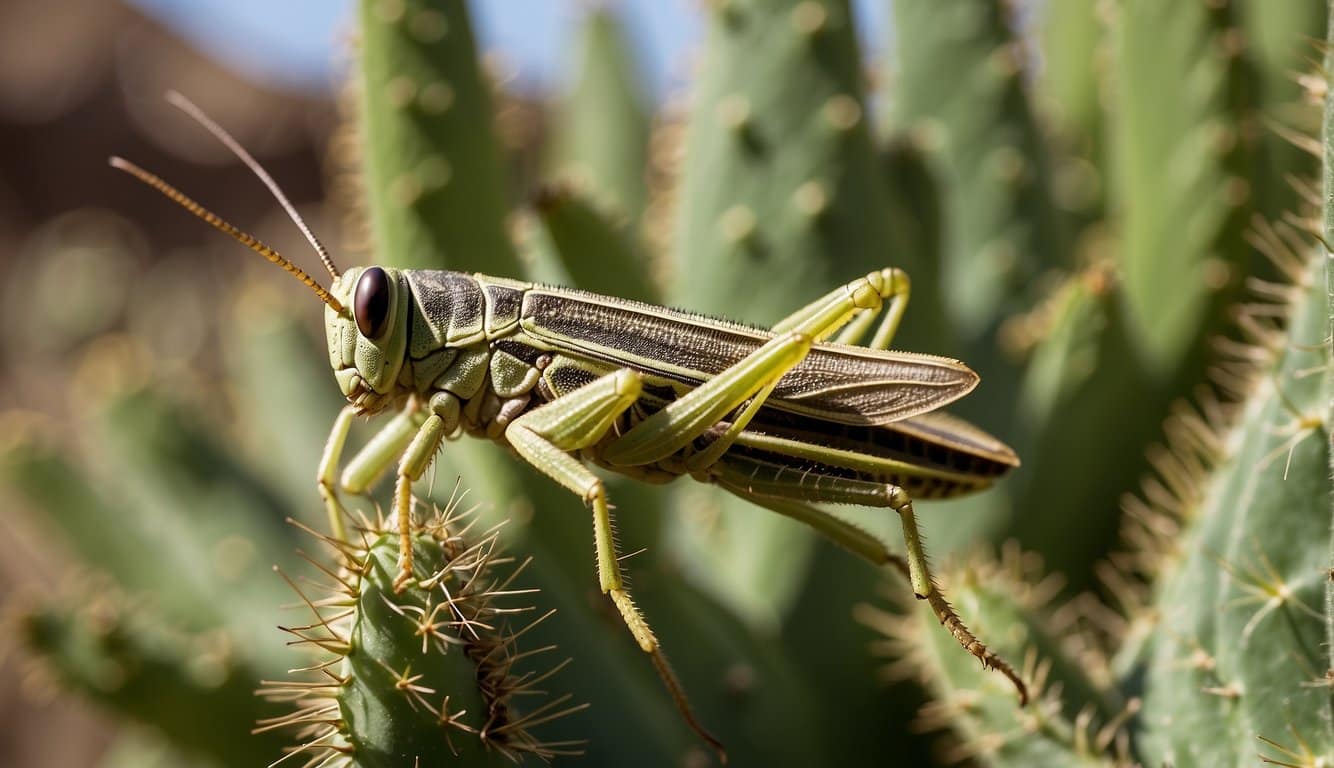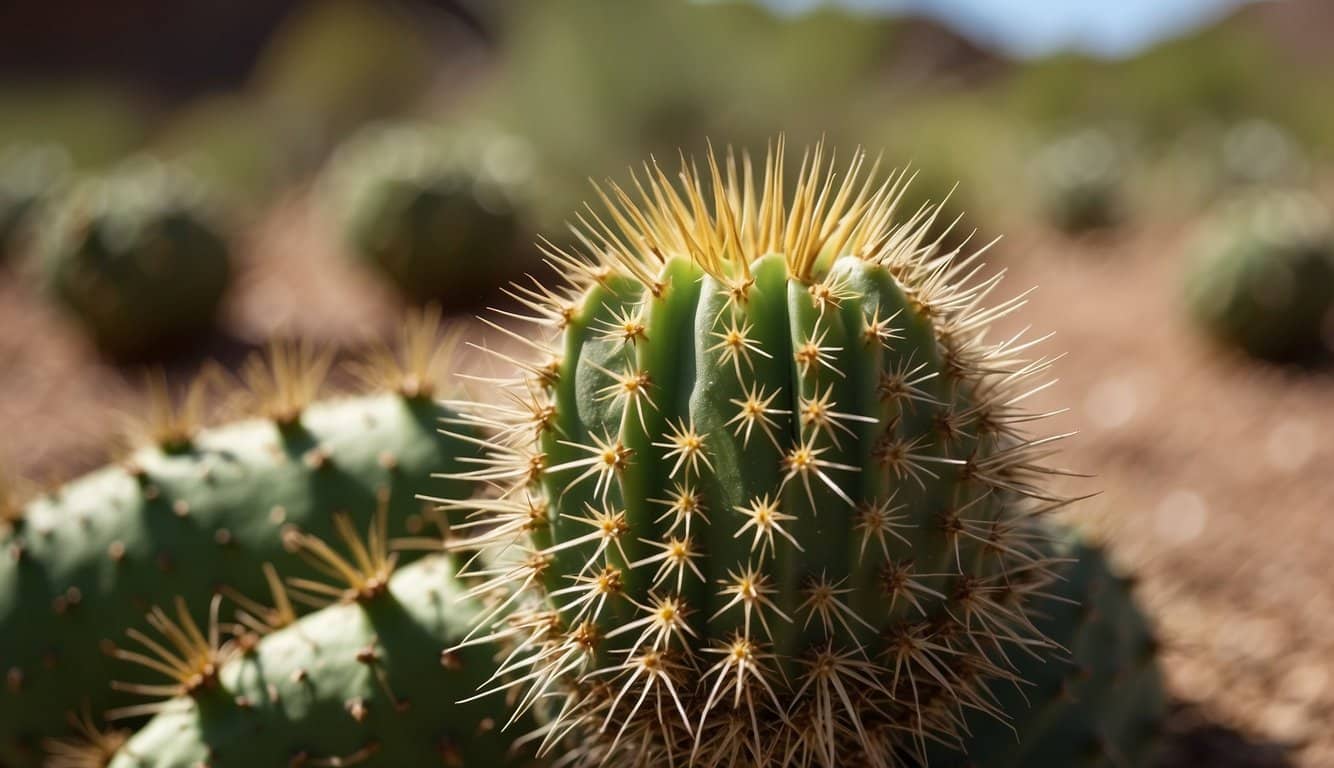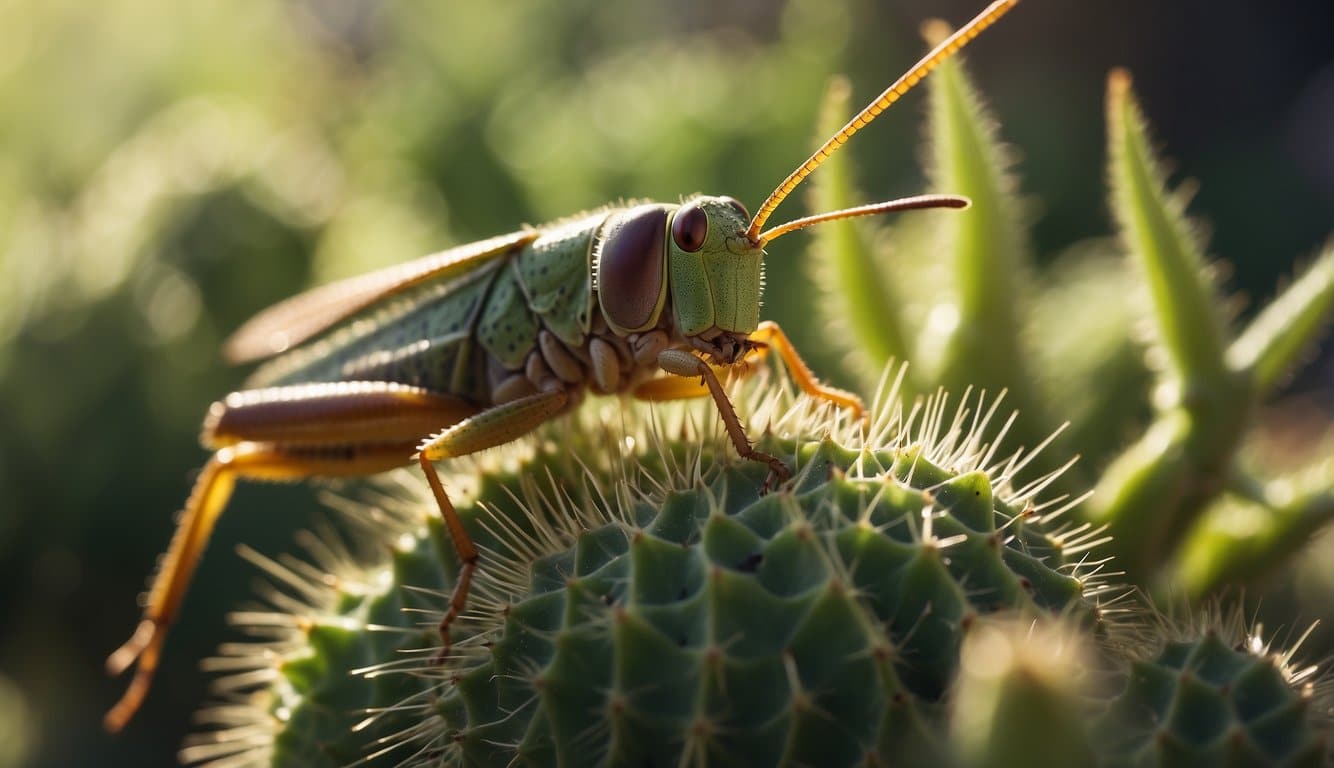Grasshoppers are known for their varied diet, typically consisting of plant material. Their adaptability has often sparked curiosity regarding their potential to consume less common plants, such as cacti.
The question of whether grasshoppers eat cactus plants arises from an awareness of the plant’s unique defenses, like spikes and toxic chemicals, which one would assume serve as deterrents to most herbivores.
However, observations and studies suggest that these desert dwellers are not exempt from the grasshoppers’ menu. These insects have been noted to feed on a range of cactus species, indicating that their feeding choices extend beyond the soft, green leaves commonly associated with their diet.
The dynamics of grasshopper feeding behavior on cacti reveal not just an exception to their usual diet but also raise questions about their physiological resilience to plant defenses.
Grasshoppers have developed adaptations over time that enable them to handle the tough exteriors and protective spines of certain cacti. This has implications for understanding grasshopper survival strategies in arid habitats, where cacti are abundant and other vegetation may be sparse.
Additionally, the interaction between grasshoppers and cacti provides insights into the complexities of desert ecosystems and the food webs within them.
Key Takeaways
- Grasshoppers include cacti in their diet, despite the plant’s defensive adaptations.
- Adaptations of grasshoppers allow them to eat cacti, showing their dietary flexibility.
- The relationship between grasshoppers and cacti contributes to our understanding of desert ecosystems.
Grasshopper Dietary Preferences
Grasshoppers exhibit a fascinating adaptability in their diet, selecting food sources that can range from general plant material to more specialized choices under certain environmental conditions.
Cacti as a Food Source
Grasshoppers are known to consume a variety of plants, but it may come as a surprise that cacti can be included in their diet.
Contrary to what one might expect given the tough, spiny exterior of cacti, these insects are capable of feeding on them, especially in arid environments where alternative food sources are scarce.
Grasshoppers use their strong mandibles to navigate through the plant’s defenses, making the most of this water-rich food source during times of drought.
Plant Selection and Nutrition
Grasshoppers generally prefer plants that provide a balance of nutrients and moisture.
While they are mostly known for consuming grasses and leaves, their ability to feed on cacti illustrates their dietary flexibility.
The selection of plants, including cacti, may vary due to factors such as:
- Availability: Presence of particular plants in the environment.
- Nutritional Need: Seeking out specific nutrients for survival.
- Moisture Content: Plants with higher water content may be favored in drier conditions.
ItalicsIndicating the adaptive nature of grasshoppers, their diet reflects their survival strategies in diverse ecosystems. They do not rely solely on cacti but will incorporate them into their diet when beneficial.
Grasshopper Feeding Behavior
Grasshoppers are known for their polyphagous nature, meaning they feed on a diverse range of plant material. This section delves into their specific eating habits and their relationship with cacti.
Eating Habits
Grasshoppers exhibit a wide array of feeding behaviors, typically feasting on a range of plant-based materials. They display a preference for green leaves and are considered herbivorous.
- Leafy Greens: A primary food source, including fresh and decaying matter.
- Plant Variety: They consume various plants, extending to crops and ornamentals.
- Feeding Time: Generally, grasshoppers feed most actively during the day.
Cactus Consumption
When it comes to cacti, grasshoppers do not typically include them in their regular diet due to the plant’s sharp spines and potentially toxic chemicals.
However, in environments where food sources are limited, such as during droughts, some species of grasshoppers may resort to feeding on this tough plant.
- Drought Conditions: Increased likelihood of cactus consumption.
- Damage Potential: Capable of causing significant harm to cacti when alternative food is scarce.
Cactus Defense Mechanisms
Cacti have evolved sophisticated defense mechanisms to protect themselves from herbivores such as grasshoppers.
Physical Defenses
Cacti primarily rely on their physical structure to deter predators. Key physical defenses include:
- Thorns and Spines: These are the most visible physical defense of cacti. They vary in size, shape, and density.
- Function: Thorns are sharp, making it difficult and painful for animals to eat the cacti.
- Variation: Some thorns are long and thin to entangle pests, while others are short and thick for maximized deterrence.
- Tough Skin: Cactus skin is thick and waxy, reducing water loss and preventing animals from easily accessing the internal moisture.
Chemical Defenses
Cacti also possess chemical defenses that complement their physical barriers:
- Toxic Chemicals: Some cacti contain compounds that are toxic or unpalatable to animals, which helps to prevent consumption.
- Bitter Tastes: The chemicals often taste bitter, further deterring herbivores from eating them.
Frequently Asked Questions
This section addresses some relevant queries regarding the diet of grasshoppers in desert climates, particularly their interaction with cacti.
What are the common food sources for grasshoppers in desert environments?
In desert environments, grasshoppers typically feed on a variety of grasses, shrubs, and flowering plants that can withstand arid conditions.
Can grasshoppers consume the leaves of cactus plants?
Yes, grasshoppers can consume the leaves of cactus plants. Despite the plant’s spiny defenses, these insects have adapted to eat various parts of the cacti.
Do grasshoppers feed on the seeds produced by cacti?
Grasshoppers have been known to feed on cactus seeds as part of their diet. They often take advantage of the full range of available plant parts including seeds.
What variety of plants are included in a grasshopper’s diet?
A grasshopper’s diet is varied and includes leaves, stems, seeds, and sometimes fruit from a wide array of plant species, not limited to cacti.
Are there any insects that typically eat cactus plants?
Aside from grasshoppers, several other insects like the cactus moth caterpillar and cactus beetles also feed on cactus plants.
How do grasshoppers adapt their feeding habits to arid ecosystems?
Grasshoppers adapt to arid ecosystems by finding nutritious food sources such as cacti that thrive in these regions. They also adjust their feeding times to avoid extreme heat.
